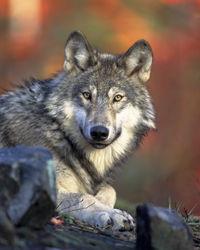


|
Carnivora:
The diverse order Carnivora IPA: [kɑː(r)ˈnɪvɔːˌrə] (from Latin carō (stem carn-) 'flesh', + vorāre 'to devour') includes over 260 placental mammals. While the Giant Panda is almost exclusively a herbivore (although it does occasionally eat fish, eggs and insects), nearly all others eat meat as their primary diet item: some (like the cat family) almost exclusively, others (like the bears and foxes) are more omnivorous. Members of Carnivora have a characteristic skull shape, and their dentition includes prominent canines and carnassials. Phylogeny:
Older classification schemes divided the order into two suborders, Fissipedia (which included the families of primarily land carnivores) and Pinnipedia (which included the true seals, eared seals, and walrus). However, even at the time, it was recognized that the Fissipedia was a paraphyletic group: the pinnipeds were not the sister group to the fissipeds but rather had arisen from among them. Newer classification schemes have been able to integrate the findings from molecular techniques for discovering genetic relationships. They generally divide the Carnivora into the suborders Feliformia (cat-like) and Caniformia (dog-like), the latter of which includes the pinnipeds. The pinnipeds are part of a clade, known as the Arctoidea, which also includes the bears and the superfamily Musteloidea. The Musteloidea in turn consists of the mustelids, procyonids, skunks and Ailurus. The dogs are the sister group to the entire arctoid assemblage; they were the first of the extant caniforms to split from the others. The same studies finally resolve the exact position of Ailurus: the Red Panda is neither a procyonid nor an ursid, but forms a monotypic family with the other musteloids as its closest living relatives. The same study also shows that the mustelids are not a primitive family, as was once thought. Their small body size is a secondary trait — the primitive body form of the arctoids was large, not small. Recent molecular studies suggest that the endemic Carnivora of Madagascar, including three genera usually classed with the civets and four genera of mongooses classed with the Herpestidae, are all descended from a single ancestor. They form a single sister taxon to the Herpestidae. The hyenas are also closely related to this clade. The exact position of the cats in relation to the other families is somewhat disputed. Nandinia, the African Palm Civet, seems to be the most primitive of all the feliforms and the very first to split from the others. The Asiatic linsangs of the genus Prionodon (traditionally placed in the Viverridae) might form a family of their own as well, as some recent studies indicate that Prionodon is actually the closest living relative to the cats. The position of extinct carnivore families is not clear. Recent studies suggest that the ancient families Miacidae and Viverravidae are not basal members of the Caniformia and Feliformia, so they are not the direct ancestors of any living carnivore family. The Miacidae is not even monophyletic, rather it appears to represent a paraphyletic array of stem taxa. Traditionally, the Miacidae and the Viverravidae have been classified in a third, extinct paraphyletic superfamily, the Miacoidea, from which the direct ancestors of the other two superfamilies arose. The Nimravidae are sometimes seen as the most basal of all feliforms, and the first to split from the others. Other studies, however, indicate that the nimravids (or at least the subfamily Barbourofelinae) are closely related to the felids. The position of many extinct felids is not clear — they may or may not be true cats after all. The amphicyonids are the first of the caniforms to split off — they are not the sister group to the ursids (as most scientists once thought) but are rather an outgroup to all other caniforms. The results of the same study further suggest a much younger minimum age for the crown-clade Carnivora (the divergence age of the subclades Caniformia and Feliformia) than had been inferred in many previous studies: middle-Eocene (ca. 43 million years ago), rather than early Paleocene (60 Ma). It remains unknown if the Creodonta are the closest relatives of the Carnivora, but it seems they are. They are united with the Pholidota and some extinct orders in the clade Ferae. |
